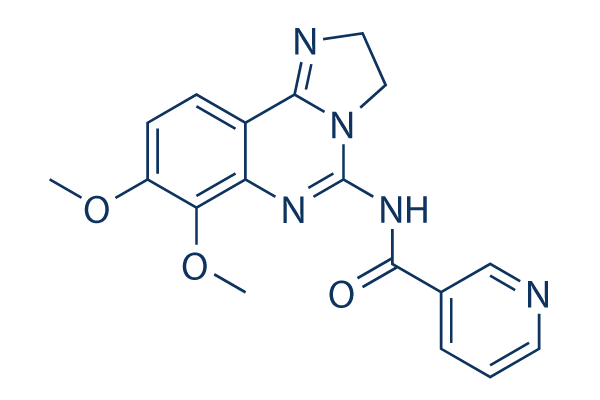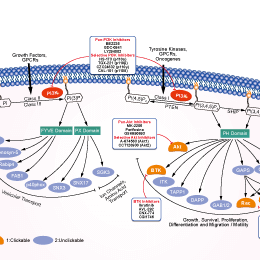
- Bioactive Compounds
- By Signaling Pathways
- PI3K/Akt/mTOR
- Epigenetics
- Methylation
- Immunology & Inflammation
- Protein Tyrosine Kinase
- Angiogenesis
- Apoptosis
- Autophagy
- ER stress & UPR
- JAK/STAT
- MAPK
- Cytoskeletal Signaling
- Cell Cycle
- TGF-beta/Smad
- DNA Damage/DNA Repair
- Compound Libraries
- Popular Compound Libraries
- Customize Library
- Clinical and FDA-approved Related
- Bioactive Compound Libraries
- Inhibitor Related
- Natural Product Related
- Metabolism Related
- Cell Death Related
- By Signaling Pathway
- By Disease
- Anti-infection and Antiviral Related
- Neuronal and Immunology Related
- Fragment and Covalent Related
- FDA-approved Drug Library
- FDA-approved & Passed Phase I Drug Library
- Preclinical/Clinical Compound Library
- Bioactive Compound Library-I
- Bioactive Compound Library-Ⅱ
- Kinase Inhibitor Library
- Express-Pick Library
- Natural Product Library
- Human Endogenous Metabolite Compound Library
- Alkaloid Compound LibraryNew
- Angiogenesis Related compound Library
- Anti-Aging Compound Library
- Anti-alzheimer Disease Compound Library
- Antibiotics compound Library
- Anti-cancer Compound Library
- Anti-cancer Compound Library-Ⅱ
- Anti-cancer Metabolism Compound Library
- Anti-Cardiovascular Disease Compound Library
- Anti-diabetic Compound Library
- Anti-infection Compound Library
- Antioxidant Compound Library
- Anti-parasitic Compound Library
- Antiviral Compound Library
- Apoptosis Compound Library
- Autophagy Compound Library
- Calcium Channel Blocker LibraryNew
- Cambridge Cancer Compound Library
- Carbohydrate Metabolism Compound LibraryNew
- Cell Cycle compound library
- CNS-Penetrant Compound Library
- Covalent Inhibitor Library
- Cytokine Inhibitor LibraryNew
- Cytoskeletal Signaling Pathway Compound Library
- DNA Damage/DNA Repair compound Library
- Drug-like Compound Library
- Endoplasmic Reticulum Stress Compound Library
- Epigenetics Compound Library
- Exosome Secretion Related Compound LibraryNew
- FDA-approved Anticancer Drug LibraryNew
- Ferroptosis Compound Library
- Flavonoid Compound Library
- Fragment Library
- Glutamine Metabolism Compound Library
- Glycolysis Compound Library
- GPCR Compound Library
- Gut Microbial Metabolite Library
- HIF-1 Signaling Pathway Compound Library
- Highly Selective Inhibitor Library
- Histone modification compound library
- HTS Library for Drug Discovery
- Human Hormone Related Compound LibraryNew
- Human Transcription Factor Compound LibraryNew
- Immunology/Inflammation Compound Library
- Inhibitor Library
- Ion Channel Ligand Library
- JAK/STAT compound library
- Lipid Metabolism Compound LibraryNew
- Macrocyclic Compound Library
- MAPK Inhibitor Library
- Medicine Food Homology Compound Library
- Metabolism Compound Library
- Methylation Compound Library
- Mouse Metabolite Compound LibraryNew
- Natural Organic Compound Library
- Neuronal Signaling Compound Library
- NF-κB Signaling Compound Library
- Nucleoside Analogue Library
- Obesity Compound Library
- Oxidative Stress Compound LibraryNew
- Plant Extract Library
- Phenotypic Screening Library
- PI3K/Akt Inhibitor Library
- Protease Inhibitor Library
- Protein-protein Interaction Inhibitor Library
- Pyroptosis Compound Library
- Small Molecule Immuno-Oncology Compound Library
- Mitochondria-Targeted Compound LibraryNew
- Stem Cell Differentiation Compound LibraryNew
- Stem Cell Signaling Compound Library
- Natural Phenol Compound LibraryNew
- Natural Terpenoid Compound LibraryNew
- TGF-beta/Smad compound library
- Traditional Chinese Medicine Library
- Tyrosine Kinase Inhibitor Library
- Ubiquitination Compound Library
-
Cherry Picking
You can personalize your library with chemicals from within Selleck's inventory. Build the right library for your research endeavors by choosing from compounds in all of our available libraries.
Please contact us at [email protected] to customize your library.
You could select:
- Antibodies
- Bioreagents
- qPCR
- 2x SYBR Green qPCR Master Mix
- 2x SYBR Green qPCR Master Mix(Low ROX)
- 2x SYBR Green qPCR Master Mix(High ROX)
- Protein Assay
- Protein A/G Magnetic Beads for IP
- Anti-Flag magnetic beads
- Anti-Flag Affinity Gel
- Anti-Myc magnetic beads
- Anti-HA magnetic beads
- Magnetic Separator
- Poly DYKDDDDK Tag Peptide lyophilized powder
- Protease Inhibitor Cocktail
- Protease Inhibitor Cocktail (EDTA-Free, 100X in DMSO)
- Phosphatase Inhibitor Cocktail (2 Tubes, 100X)
- Cell Biology
- Cell Counting Kit-8 (CCK-8)
- Animal Experiment
- Mouse Direct PCR Kit (For Genotyping)
- New Products
- Contact Us
PIK-90
PIK-90 is a PI3Kα/γ/δ inhibitor with IC50 of 11 nM/18 nM/58 nM, respectively, less potent to PI3Kβ.

PIK-90 Chemical Structure
CAS No. 677338-12-4
Purity & Quality Control
Batch:
Purity:
99.9%
99.9
PIK-90 Related Products
Signaling Pathway
Biological Activity
| Description | PIK-90 is a PI3Kα/γ/δ inhibitor with IC50 of 11 nM/18 nM/58 nM, respectively, less potent to PI3Kβ. | ||||||||
|---|---|---|---|---|---|---|---|---|---|
| Targets |
|
| In vitro | ||||
| In vitro | PIK-90 shows distinct patterns of isoform selectivity to inhibit different subsets of four class I PI3K isoforms. In addition, PIK-90 completely inhibits the fMLP-stimulated phosphorylation of Akt and impairs polarity and chemotaxis in dHL60 cells. [1] PIK-90 exhibits significantly antiproliferative activity by effectively blocking phosphorylation of Akt in six glioma cell lines varying in mutational status at PTEN or p53, including U87 MG, SF188, SF763, LN229, A1207 and LN-Z30 cells. Moreover, PIK-90 induces a modest G0G1 arrest at a concentration (0.5 μM) sufficient to inhibit phosphorylation of Akt substantially. [2] In chronic lymphocytic leukemia (CLL) cells, PIK-90 inhibits chemotaxis to levels that are 57.8% of controls at 1 μM and 56.8% of controls at 10 μM. Consistently, PIK-90 inhibits pseudoemperipolesis to levels that are 74.2% PIK-90 of controls at 1 μM and 57.9% of controls at 10 μM. In addition, PIK-90 also leads to a significant reduction of CLL cell migration into the stromal cell layer and decreases CXCL12-induced actin polymerization. [3] | |||
|---|---|---|---|---|
| Kinase Assay | Expression and Assay of p110α/p85α, p110β/p85α, p110δ/p85α, and p110γ | |||
| IC50 values are measured using either a standard TLC assay for lipid kinase activity or a high-throughput membrane capture assay. Kinase reactions are performed by preparing a reaction mixture containing kinase, inhibitor (2% DMSO final concentration), buffer (25 mM HEPES, pH 7.4, 10 mM MgCl2), and freshly sonicated phosphatidylinositol (100 μg/mL). Reactions are initiated by the addition of ATP containing 10 μCi of γ-32P-ATP to a final concentration 10 μM or 100 μM, and allowed to proceed for 20 minutes at room temperature. For TLC analysis, reactions are then terminated by the addition of 105 μL 1N HCl followed by 160 μL CHCl3:MeOH (1:1). The biphasic mixture is vortexed, briefly centrifuged, and the organic phase transferred to a new tube using a gel loading pipette tip precoated with CHCl3. This extract is spotted on TLC plates and developed for 3-4 hours in a 65:35 solution of n-propanol:1M acetic acid. The TLC plates are then dried, exposed to a phosphorimager screen, and quantitated. For each compound, kinase activity is typically measured at 10-12 inhibitor concentrations representing two-fold dilutions from the highest concentration tested (100 μM). For compounds showing significant activity, IC50 determinations are repeated two to four times, and the reported value is the average of these independent measurements. | ||||
| Cell Research | Cell lines | U87 MG, SF188, SF763, LN229, A1207 and LN-Z3 cells | ||
| Concentrations | 0 to 1 μM | |||
| Incubation Time | 72 hours | |||
| Method | For viabilty, cells are seeded in 12-well plates in the presence of PIK-90 for 3 days. Cell viability is determined using a WST-1 assay. | |||
| In Vivo | ||
| In vivo | Immediately following insulin treatment, PIK-90 (10 mg/kg) completely protects animals from this insulin-stimulated decline in blood glucose. [4] | |
|---|---|---|
| Animal Research | Animal Models | FVB/N female mice are fasted at 9:00 a.m. and then given human insulin or vehicle (PBS) intravenously at 12:00 p.m. |
| Dosages | ≤10 mg/kg | |
| Administration | Administered via i.p. | |
Chemical Information & Solubility
| Molecular Weight | 351.36 | Formula | C18H17N5O3 |
| CAS No. | 677338-12-4 | SDF | Download PIK-90 SDF |
| Smiles | COC1=C(C2=NC(=NC(=O)C3=CN=CC=C3)N4CCNC4=C2C=C1)OC | ||
| Storage (From the date of receipt) | |||
|
In vitro |
DMSO : 2 mg/mL ( (5.69 mM) Moisture-absorbing DMSO reduces solubility. Please use fresh DMSO.) Water : Insoluble Ethanol : Insoluble |
Molecular Weight Calculator |
|
In vivo Add solvents to the product individually and in order. |
In vivo Formulation Calculator |
||||
Preparing Stock Solutions
Molarity Calculator
In vivo Formulation Calculator (Clear solution)
Step 1: Enter information below (Recommended: An additional animal making an allowance for loss during the experiment)
mg/kg
g
μL
Step 2: Enter the in vivo formulation (This is only the calculator, not formulation. Please contact us first if there is no in vivo formulation at the solubility Section.)
% DMSO
%
% Tween 80
% ddH2O
%DMSO
%
Calculation results:
Working concentration: mg/ml;
Method for preparing DMSO master liquid: mg drug pre-dissolved in μL DMSO ( Master liquid concentration mg/mL, Please contact us first if the concentration exceeds the DMSO solubility of the batch of drug. )
Method for preparing in vivo formulation: Take μL DMSO master liquid, next addμL PEG300, mix and clarify, next addμL Tween 80, mix and clarify, next add μL ddH2O, mix and clarify.
Method for preparing in vivo formulation: Take μL DMSO master liquid, next add μL Corn oil, mix and clarify.
Note: 1. Please make sure the liquid is clear before adding the next solvent.
2. Be sure to add the solvent(s) in order. You must ensure that the solution obtained, in the previous addition, is a clear solution before proceeding to add the next solvent. Physical methods such
as vortex, ultrasound or hot water bath can be used to aid dissolving.
Tech Support
Answers to questions you may have can be found in the inhibitor handling instructions. Topics include how to prepare stock solutions, how to store inhibitors, and issues that need special attention for cell-based assays and animal experiments.
Tel: +1-832-582-8158 Ext:3
If you have any other enquiries, please leave a message.
* Indicates a Required Field
Tags: buy PIK-90 | PIK-90 supplier | purchase PIK-90 | PIK-90 cost | PIK-90 manufacturer | order PIK-90 | PIK-90 distributor







































